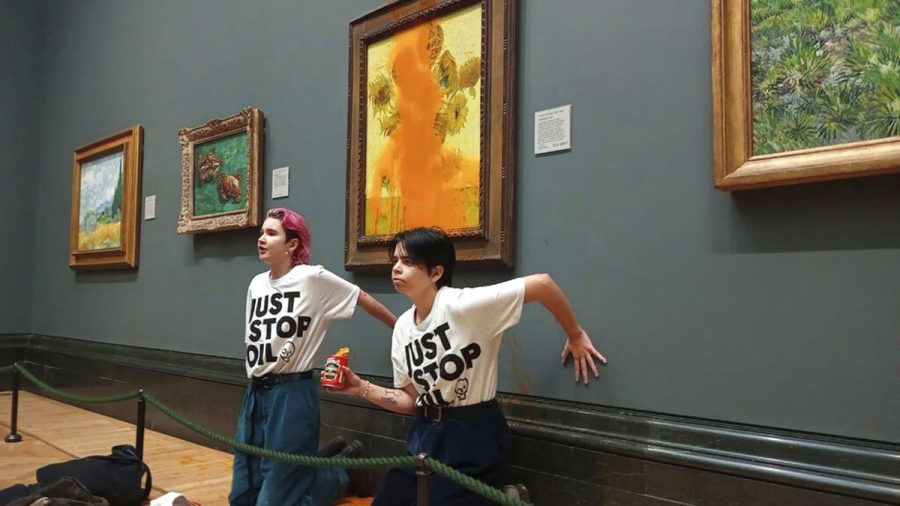Were Protesters Right to Deface Van Gogh’s Famous Painting?
Photo provided by Just Stop Oil
Protesters sit super-glued to the wall underneath the vandalized painting, “Sunflowers” which was protected by glass and saw only minor damages to the frame. Specialized officers came soon after to remove and arrest the individuals.
October 24, 2022
Two activists walked into the National Art Gallery in London the morning of Oct. 14 with cans of tomato soup and tubes of superglue stuffed into their jackets. They walked straight into room 43 and threw the contents of their cans at Vincent Van Gogh’s “Sunflowers” before supergluing their hands to the wall and performing a sit-in. A video of the event was released shortly after, which was meant to highlight the fuel crisis as an effect of fossil fuel production. However that’s not what most people were talking about. After the clip circulated social media, users argued from all different angles about whether the vandalism took things too far, and if it possibly harmed the climate change movement.
Destroying or damaging art as a form of awareness is nothing new. These incidents attract a large amount of attention from news outlets and the general public, which is exactly what activists are looking for. But the Vincent Van Gogh demonstration may have attracted the wrong kind of attention. Tad Stolz, a sophomore, gave their thoughts after watching the video: “I think we should be making our voices heard. However, I don’t think we should be doing that by vandalizing sacred art that has nothing to do with climate change.”
That doesn’t mean art vandalism is a completely lost cause as far as protesting. It can be an effective way to create a conversation, as long as it’s done correctly. During the BLM protests in the aftermath of George Floyd’s death, one statue, titled “Serve and Protect” in Salt Lake City, was defaced. The statue was a dedication to the city’s officers, but was splattered with red paint during one protest in front of the department, completely changing the meaning of the art piece. It was a brilliant use of symbolism that garnered a lot of positive press for the movement.
What makes this demonstration in Salt Lake City so different from the one in London is the choice of art being vandalized. The “Serve and Protect” piece had a clear link to police brutality, which was highlighted by the vandalism. Without an explanation or press release, onlookers knew exactly what the message was; that the city’s police department had blood on their hands. Looking at the Van Gogh incident compared to this example, it’s clear that the climate protesters made some crucial mistakes.
Though the video of the demonstration included a speech about the English government’s lack of action in response to the climate crisis, the message of the stunt still wasn’t clear to the public. Unlike Salt Lake City, there isn’t a clear connection between Van Gogh’s painting and the points being made by protestors. Later, another video was released with one of the protesters explaining, “…it looks like a slightly ridiculous action. I agree, it is ridiculous…What we’re doing is getting the conversation going.”
It’s clear that the stunt was entirely for attention, with the organization behind it not caring about positive versus negative press. This is what makes the Van Gogh vandalism a poor example of art vandalism as a means of protest. That being said, there have been arguments on all sides. Some social media users are saying that those getting mad at the videos are part of the problem, and should reexamine their priorities; while others think that disruptive protests harm the movements they’re trying to advocate for. The truth of the matter is that these types of protests aren’t going away. This past Sunday, another set of climate advocates threw mashed potatoes at a Monet painting in Germany. Environmentalists interrupted Ted Cruz’s interview with The View earlier today, and ABC was forced to shut off the broadcast’s audio. Vandalism, road blocks, and all kinds of disruptive protests are only becoming more popular, and the activists behind them won’t stop until the message is heard, and action is taken.












